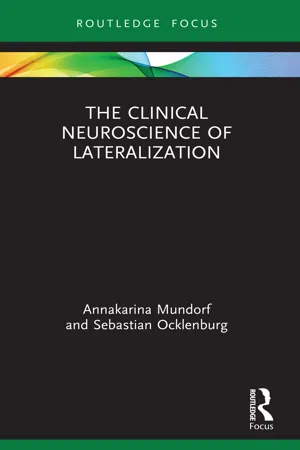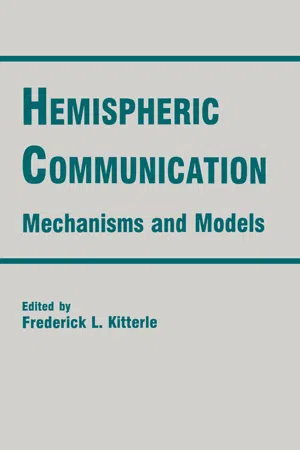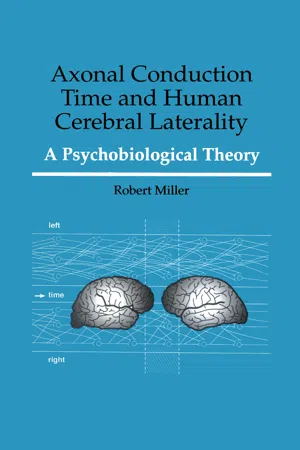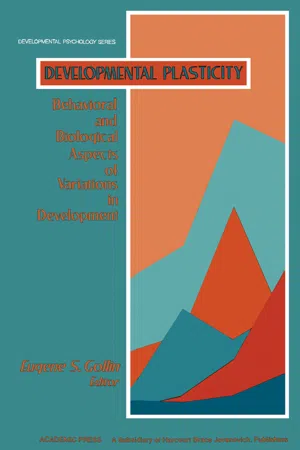Psychology
Lateralisation
Lateralisation refers to the specialization of functions in the two hemispheres of the brain. In the context of psychology, it is often associated with the idea that certain cognitive functions are more dominant in one hemisphere than the other. For example, language processing is typically lateralized to the left hemisphere, while spatial processing is more dominant in the right hemisphere.
Written by Perlego with AI-assistance
Related key terms
1 of 5
12 Key excerpts on "Lateralisation"
- eBook - ePub
- Regina Pally(Author)
- 2018(Publication Date)
- Routledge(Publisher)
In this century, in the 1930s, Lange revitalised interest in the central importance of the right hemisphere. He recognised that the right hemisphere provides a general contextual background to a person’s world view. During the 1960s the initial work of Sperry and Gazzaniga (Gazzaniga et al., 1962) at first seemed to corroborate the ‘two minds, two consciousnesses’ view held by some late nineteenth-century scientists. Subsequent work, however, resulted in the now generally accepted ‘asymmetric but integrated’ perspective. The right and left cerebral cortex are each lateralised for specialised functions, but in the healthy brain the two hemispheres share their information and operate collaboratively (Joseph, 1996; Deacon, 1997; Gazzaniga, 1995; Ornstein, 1997).Research regarding latéralisation of specialised functions pertains mostly to cortical functions. However, it must be remembered that specialised functions of each cortex are influenced by input from subcortical structures as well as from other cortical sites in the same or opposite hemisphere. According to Deacon, functional asymmetry evolved because in certain circumstances organisms must prioritise, and have only one goal, express only one action, or speak only one thought. For these particular functions only one hemisphere must have the advantage.Neuroscientists assume that the reason that language and fine motor movements are lateralised to the left cerebral cortex and emotion and musical ability to the right cerebral cortex is a fundamental difference between the left and right cortices with respect to information processing (Galin, 1974; Tucker, 1981). The left is better at analysing rapid temporal-sequential aspects of information. Therefore the left hemisphere more readily identifies ‘details’ and notices precise distinctions, rendering an advantage to the left in the specialised functions of language, causal relationships and fine motor movements. By contrast, the right is better at analysing the global, overall relationship aspects of information. Therefore the right more readily identifies context and gets the overall picture of the situation, giving an advantage to the right hemisphere in processing social interactions, emotional experience and visual-spatial tasks. One metaphor often used is that the left is a digital ‘computer’ and the right an analogue ‘computer. Another is that the left provides the ‘text’ and the right the ‘context’.Hemispheric dominance is relative, not absolute. Ornstein (1997) compares this to the ‘winner takes all’ in politics, where a 51 per cent majority can win the election. Translated into neuroscience this means a hemisphere does not function 100 per cent in its area of speciality, only relatively - eBook - PDF
- Manuel F. Casanova, Ayman El-Baz, Jasjit S. Suri, Manuel F. Casanova, Ayman El-Baz, Jasjit S. Suri(Authors)
- 2017(Publication Date)
- CRC Press(Publisher)
Instead, lateralization indicates that one side of the brain plays a greater role in a given cognitive process than the other, that is, their involvement is asymmetric. 137 Atypical hemispheric asymmetries in autism spectrum disorders 81 Language Language is the paradigmatic lateralized function. Though the idea that different regions of the brain are specialized for different types of function is now taken for granted, this knowledge is comparatively new. French neurosurgeon Paul Broca (1865) first suggested that the brain is lateralized for articulate language, based on his observation of patients with speech impairments. At autopsy, he noticed a pattern: patients who presented with speech problems had damage to the left hemisphere. In the 150 years since Broca’s discovery, confirmatory research has grown, indicating that though both sides of the brain contribute to language pro- cessing (see Lindell 2006), the left hemisphere is undoubtedly the supe- rior language processor in the typical brain. As left hemisphere lateralization is typically associated with normal language function, it follows that atypical language lateralization may compromise language ability. And indeed, people with developmental disorders that impair language function, including dyslexia (Xu et al. 2015), ADHD (Hale et al. 2005), and specific language impairment (Hodge et al. 2010), show evidence of reduced and/or reversed left hemi- sphere lateralization for language. Language and communication impairments form a core diagnostic criterion in ASD, and additionally play a key prognostic role (Herbert et al. 2002). For example, in children with ASD, the early presence of speech (before age 5, Mody and Belliveau 2012; before age 2, Mayo et al. 2013) is considered the strongest predictor of favorable outcomes. - eBook - ePub
Brain, Attachment, Personality
An Introduction to Neuroaffective Development
- Susan Hart(Author)
- 2018(Publication Date)
- Routledge(Publisher)
In this chapter, I will review some aspects of lateralization and its importance for certain functions. The lateralization of the brain is an area of particular theoretical dispute, and much of the theory in the area is speculative in nature. It is, however, indisputable that the brain is lateralized, and hopefully, future research will be able to provide a clearer picture of the relationship between neurophysiological differences and function.History
As early as 1904, it was clear that the brain is not only lateralized on the neocortical level but also on a deeper level, in brainstem functions. The limbic system is also lateralized, and in the human brain emotional facial expressions are processed in the right hemisphere. Recent neurophysiological research shows that hemispheric lateralization is not just found in primate brains but is also a feature of lower mammals, fish, reptiles, birds, etc. The evolutionary advantage of brain lateralization has long been the topic of speculation, and today it is generally believed that lateralization has developed in order to make room for new skills without the loss of existing skills. Lateralization makes room for additional skills because functions can be divided between the right and left hemisphere, and the two hemispheres are free to specialize in different functions (Gazzaniga, 1999; Geschwind & Galaburda, 1987; Schore, 2003b).Some functions have had to give way to new ones. For example, the expansion of the parietal and frontal lobes probably took place at the cost of the visual cortex. A look at the skulls of some of the prehistoric humans who lived some two million years ago reveals that their skulls were constructed to accommodate a much larger visual cortex than is found in modern man. In particular, the frontal motor areas in the left hemisphere expanded at this time, while there are no major changes in the corresponding areas in the right hemisphere. This development probably took place in order to accommodate language, since this is the region where we find the neural roots of language (Gazzaniga, 1999; Hansen, 2002). - eBook - ePub
- Annakarina Mundorf, Sebastian Ocklenburg(Authors)
- 2021(Publication Date)
- Routledge(Publisher)
1 Lateralization in neurodevelopmental, psychiatric, and neurological disordersIntroduction
All mental processes are brain processes, and therefore all disorders of mental functioning are biological diseases. Eric Kandel (cited in Weir 2012)This statement by Nobel Prize laureate Eric Kandel exemplifies the key assumption of modern clinical neuroscience: the roots of mental illness lie in the disruption of biological processes in the brain. This implies that, in order to understand mental illness, it is crucial to understand how and why patients suffering from mental health problems show differences in brain organization compared to healthy individuals.One of the most important organizational features of the human brain (or any vertebrate brain for that matter) is its division into two halves, or hemispheres (Ocklenburg and Güntürkün 2018). While looking mostly symmetrical on the macrostructural level, the two hemispheres show countless left-right differences, so-called hemispheric asymmetries (see next section). Among the most intriguing empirical findings related to these hemispheric asymmetries is the fact that they show alterations in almost all of the investigated psychiatric and neurodevelopmental disorders (Ocklenburg et al. 2015). These include—to name the most common examples—dyslexia (Paracchini et al. 2016), schizophrenia (Gruzelier 1984), affective disorders (Hecht 2010), autism spectrum disorders (Lindell and Hudry 2013), posttraumatic stress disorder (Meyer et al. 2015), attention deficit hyperactivity disorder (Lin and Tsuang 2018), and alcohol use disorder (Zhu et al. 2018).Despite the wealth of the published literature (there are several hundred scientific papers on hemispheric asymmetries in schizophrenia alone), the relationship between hemispheric asymmetries and psychiatric and neurodevelopmental disorders is still far from being well understood. In particular, most empirical papers focus on hemispheric asymmetries in one specific disorder, but there rarely is an overarching integration of findings across different disorders. Therefore, the present book aims to not only review empirical findings on functional and structural hemispheric asymmetries in these and other disorders but also to integrate these findings across disorders. Moreover, we aim to synthesize the findings of the biological pathways that overlap between the ontogenesis of hemispheric asymmetries and the pathogenesis of different disorders. - eBook - ePub
Hemispheric Communication
Mechanisms and Models
- Frederick L. Kitterle(Author)
- 2020(Publication Date)
- Routledge(Publisher)
2 Neuroanatomical Bases of Hemispheric Functional Specialization in the Human Brain: Possible Developmental Factors 1 Sandra F. Witelson McMaster UniversityFunctional Asymmetry: Nature and Ontogeny
Hemispheric functional specialization or functional asymmetry is a well-established characteristic of functional organization in the human brain. In essence, the right and left hemispheres have different roles in mediating various behaviors and higher mental processes. Tasks involving speech production, phonemic discrimination; comprehension of oral and written language; the ability to write; performance of voluntary finger, limb, and oral movements; and the perception of sequences of stimuli are more dependent on left- than right-hemisphere functioning in most people. In contrast, tasks involving the perception of two- and three-dimensional visual or tactual shapes, spatial position and orientation of stimuli, the perception of faces and colors, mental rotation of three-dimensional shapes, the ability to direct attention to both lateral sensory fields, the perception of musical chords and melodies, aspects of the perception of emotional stimuli and prosodie features of speech, and the abilities to dress oneself and to construct block models are more dependent on the right hemisphere. In the past decade, numerous books have summarized these findings based on the study of brain-damaged people with unilateral lesions, people who have undergone commissurotomy, and neurologically intact people who were tested with various behavioral and perceptual tests involving right- and left-sided input or output (e.g., Beaton, 1985; Boller & Grafman, 1988-1990; Bradshaw & Nettleton, 1983; Bryden, 1982; Corballis, 1983; H. Damasio & A. Damasio, 1990; Geschwind & Galaburda, 1984; Hannay, 1986; Heilman & Valenstein, 1985; Heilige, 1983; Kolb & Whishaw, 1990; Molfese & Segalowitz, 1988; Ottoson, 1987).However, several key issues related to hemispheric specialization remain unresolved. First, the lists of tests that are more dependent on one hemisphere or the other are continually expanding. There is no demonstration, however, of what specific cognitive functions are common to each set of skills and are indicative of the type or types of processing that each hemisphere is specialized for. The numerous dimensions postulated for hemispheric differences, such as verbal versus nonverbal or analytic versus synthetic, are merely inferred hypotheses derived from the numerous tasks studied, of what the essential functional characteristics of the hemispheres are. Moreover, it has been shown that it is not only the nature of the task stimuli, but also the strategy or process the subject uses to perform the task, that determines which hemisphere is dominant in processing for that task. Currently, a widely used working hypothesis is that the left hemisphere is specialized for analytic, sequential, time-dependent functions, and the right hemisphere is specialized for synthetic, spatial perceptual functions (e.g., Bradshaw & Nettleton, 1983). - eBook - PDF
- Harry A. Whitaker(Author)
- 2010(Publication Date)
- Elsevier(Publisher)
Whether this result indicates that the nature of hemispheric specialization is changed by experience, or whether more experience tends to engage more specialized processors in the brain, remains unclear. The Effect of Handedness One individual difference, that of handedness, has been clearly linked to patterns of hemispheric specialization for cognitive and emotional function. The relative specializa-tions of the cerebral hemispheres described previously appear to hold only for individuals who are right-handed. In contrast, left-handed individuals, who comprise approximately 10% of individuals worldwide, can have a diverse pattern of lateral organization. This difference is well-known by neurologists and neuropsychologists who have long observed that handedness is an important factor in predicting the types of deficits and the amount of recovery that is likely to be observed after unilateral brain damage. However, there is much variability among left-handers regarding the type of lateralized brain organiza-tion they display. In some cases, it is similar to that of right-handers, with the left hemisphere specialized for verbal functions and the right for nonverbal functions. In other cases, it is the opposite, with the right hemisphere specialized for verbal function and the left for nonverbal function. It is estimated that such a brain organization is found in only 1% or 2% of right-handers. Finally, other left-handers exhibit a pattern in which both hemispheres appear to be able to process both verbal and nonverbal information, including speech output. Although much research has attempted to isolate a factor that can predict the type of brain organization a given left-hander will exhibit, for the most part, these efforts have failed. - eBook - ePub
Neural Circuit and Cognitive Development
Comprehensive Developmental Neuroscience
- Bin Chen, Kenneth Y. Kwan(Authors)
- 2020(Publication Date)
- Academic Press(Publisher)
Shen, 2015 ). Again, this work is most meaningful when network features are linked to behavior.27.4.3.1. Lateralization
Lateralization, also referred to as hemispheric specialization or functional asymmetry, has been a historically popular explanation for cognitive sex differences, particularly for spatial and language skills. Typically, the left hemisphere, which houses both Broca's and Wernicke's areas, is dominant for sequential processing, including language, and the right hemisphere is dominant for simultaneous processing, including spatial skills (for reviews, see Bryden, 1982 ; Hall et al., 2008 ; Kansaku and Kitazawa, 2001 ; Kimura, 1999 ). Data going back several decades, derived from patients with brain damage and behavioral tasks in typical individuals (e.g., split-field visual tasks, dichotic listening, and electroencephalogram asymmetry), suggest that women are less lateralized than men, especially for language (Bryden, 1982 ; Gur and Gur, 2017 ; McGlone, 1980 ). The topic has also been studied using fMRI, but results are often task and method dependent and subject to misinterpretation. For instance, lateralization must be explicitly tested by comparing activation in the two hemispheres; it is not sufficient to show that the activity of only one hemisphere is above baseline or that there are significant sex differences in specific regions of a single hemisphere. When the correct analyses are conducted, women generally show less lateralization than men, but the effect is small. Women's reduced lateralization has been suggested to be linked to greater interhemispheric communication facilitated by their larger interhemispheric commissures and is consistent with data showing their greater interhemispheric structural connectivity (Halpern, 2012 ; Hines et al., 1992 ; Ingalhalikar et al., 2014 - eBook - ePub
Axonal Conduction Time and Human Cerebral Laterality
A Psycological Theory
- Robert Miller(Author)
- 2019(Publication Date)
- CRC Press(Publisher)
5 Perceptual Aspects of Lateralization: Theory and Predictions5.1 Introduction
From the morphological evidence reviewed above, the hypothesis that there be a richer repertoire of delay lines between different cortical areas in the left hemisphere compared to the right is at least plausible, though critical tests of the morphological aspects of the hypothesis have not yet been conducted. The evidence, such as it was, implied a global difference between the hemispheres, not confined selectively to the areas known to be primarily involved in language. This in turn has another major implication: It encourages us to think that the functional difference between the sides can be demonstrated not only with respect to language functions but with respect to a wide variety of other functions (both sensory and motor) which depend on the same lateralized differences in morphological substrate. Therefore, two further important questions are posed: What is the full range of functional differences between left and right hemispheres? Can they all be explained as direct or indirect consequences of differences between the hemispheres in the degree of temporal dispersion of signals within each hemisphere?In the present chapter, predictions will be made about the differences between the hemispheres in processing sensory signals, and in the following chapter corresponding evidence is reviewed. Admittedly, the hypothesis of the structural basis for interhemispheric differences also lends itself to predictions about differences in programming of motor output, and has implications for the higher cognitive functions of the forebrain. However, it is much easier to design experiments to evaluate temporal aspects of sensory processing than those of motor programming or cognitive processes. Discussion of the lateral differences in motor programming is therefore deferred to Chapters 8 and 9 , when they can be placed in an appropriate theoretical framework. Laterality of higher cognitive functions of the forebrain is discussed in Chapter 10 - eBook - PDF
Developmental Plasticity
Behavioral and Biological Aspects of Variations in Development
- Eugene Gollin(Author)
- 2012(Publication Date)
- Academic Press(Publisher)
The absence of an asymmetry re-flects the utilization of processes that are symmetrically organized in all age groups, processes that are bypassed in adults in favor of superior and later-ally differentiated cognitive operations that are immature in children. If the degree of lateralization does not increase with development, what mechanisms underlie the progressive loss of plasticity for lateral reorganiza- 6. LATERALIZATION AND ITS IMPLICATIONS FOR VARIATION IN DEVELOPMENT 187 tion? How does a single hemisphere, deprived of its partner on the other side, come to have such a high degree of bifunctional competence if hemispherectomy is performed in childhood? Bifunctional competence of both hemispheres, similar to that seen in cases of infantile hemiplegia, is found in individuals with agenesis of the corpus callosum (Jeeves, 1 9 6 9 , 1972; Netley, 1977; Saul & Sperry, 1 9 6 8 ) , suggesting that each hemis-phere, in the normal course of development, actively inhibits development of its own specialized functions within the other side of the brain: Loss of a hemisphere or absence of the major communicating pathway between hemispheres during critical maturational stages allows secondary programs in each hemisphere to mature and become elaborated, as we suppose usually happens only for the primary program of specialization. It is being suggested that the infant is born with a primary program of specialization, as well as a less developed and less competent secondary pro-gram for the other hemisphere's specialties; that in the normal course of maturation, the secondary program fails to mature and undergoes functional regression as neural organization matures in service of the major specialized functions. - eBook - PDF
- Michael Corballis(Author)
- 2012(Publication Date)
- Academic Press(Publisher)
Functional Asymmetry of the Human Brain In the great majority of people, perhaps 95%, language is represented pri-marily in the left cerebral hemisphere, whereas certain nonverbal functions are represented more strongly in the right hemisphere. The concern of this chapter is to document and characterize this typical pattern of asymmetry. A minority of individuals show systematic departures from this pattern, and these will be considered in the following chapter, in which cerebral lateralization is related to handedness and other asymmetries. LATERALIZED REPRESENTATION OF LANGUAGE Lesion Studies The discovery that language is represented predominantly in the left side of the brain in most people is usually attributed to Marc Dax, an obscure general practitioner whose one and only contribution to science was a short paper read in 1836 at a medical society in Montpelier, France. Dax observed that in more than 40 patients suffering from disturbances of speech there were signs of dam-age to the left cerebral hemisphere. He could find not a single case in which there was evidence of damage to the right hemisphere only. Dax concluded that speech is controlled by the left cerebral hemisphere. Dax's historic insight initially made no impact, and indeed it might not have been recognized at all had it not been for the efforts of his son nearly 30 3 29 30 3. Functional Asymmetry of the Human Brain years later. Anxious to establish his father's priority, Gustav Dax located the text of the original talk and arranged for it to be published in 1865 (Springer & Deutsch, 1981). In the meantime, in 1861, Paul Broca had read a case study to the Anatomical Society of Paris in which he described the results of a post mortem examination of the brain of an aphasic patient known as Tan, so called because this was the only articulate sound he could make. - eBook - PDF
- Ellen Perecman(Author)
- 2012(Publication Date)
- Academic Press(Publisher)
THEORETICA L ISSUE S IN RIGH T HEMISPHER E NEUROPSYCHOLOG Y PART 1 This page intentionally left blank 2 Cerebra l Lateralization , Cognitiv e Asymmetry , and Huma n Consciousnes s T. G. BEVER The study of cerebral asymmetries in humans has been a major area of growth in psychology for the past several decades. This is in part a result of the emergence of sophisticated experimental techniques that can be used with normal populations, and in part a result of medical technology which has provided spectacular cases of disconnected or absent hemispheres. Ce-rebral asymmetries are important because they are typically human and be-cause they constitute an example of localization of function—crude as that localization may be. By studying simple asymmetries, one hopes, we will understand our own biology better, as well as gain insight into general laws governing the relation between brain and behavior. Unfortunately, such hopes have been slow to be fulfilled, and our under-standing of the phenomena recedes exactly as fast as new investigative tech-niques develop, or slightly faster. This chapter reviews some devastating problems that riddle the field, leaving us uncertain as to how to interpret most of the existing literature on normal subjects. These problems involve (a) subject variables, (b) task variables, and (c) the need for an indepen-dently motivated theory of congnitive behavior to test against functional asymmetries. COGNITIV E PROCESSIN G IN TH E RIGH T HEMISPHER E 19 Copyrigh t ' 1983 by Academi c Press , Inc . All right s of reproductio n in an y for m reserved . ISBN 0-12-550680-5 20 T. G. Bever Cerebral asymmetries, in fact, constitute one of the most complex prob-lems we could choose as an example of the relation between brain and be-havior. Since, in fact, we have little choice, we must find ways to make the best of a nearly impossible situation. - eBook - PDF
- S. J. Segalowitz(Author)
- 2014(Publication Date)
- Academic Press(Publisher)
Just as it is incorrect to expect that a single score will accurately reflect all lateral preferences, we should expect there to be multiple factors in hemispheric organization for language and for other cognitive functions. Now, this is taken for granted when, as in Part I of this book, we see a conscious division of language into various functions. However, perhaps we should go further yet, and allow that some people may have divergent enough early linguistic experiences that their neuropsychological organi-zation for language may be different. For example, the cognitive require-ments of sign languages for the deaf such as American Sign Language (ASL), may promote a different organization (see Ross's chapter, this volume); the bilingual's second language may not rest on the same neuro-physiological basis as the first, if there is a different developmental history associated with it (see Vaid's chapter, this volume). Individual differ-ences in hemispheric organization may be due to many factors, not all of which are amenable to measurement. An important next step in neurolin-guistics is to recognize these factors, even if they cannot be measured, devise control tasks for them, and make use of appropriate statistical models to take them into account (see Segalowitz's and Bryden's chapter, this volume). REFERENCES Blumstein, S., Goodglass, H., and Tartter, V. (1975). The reliability of ear advantage in di-chotic listening. Brain and Language, 2, 226-236. Bryden, M. P. (1965). Tachistoscopic recognition, handedness, and cerebral dominance. Neurospychologia, 3, 1-8. Fennell, E. B., Bowers, D., and Satz, P. (1977). Within-modal and cross-modal reliabilities of two laterality tests. Brain and Language, 4, 63-69. Hiscock, M. & Kinsbourne, M. (1980). Asymmetry of verbal-manual time sharing in chil-dren: a follow-up study. Neuropsychologia, 18, 151-162. Molfese, D. L. (1978). Neuroelectrical correlates of categorical speech perception in adults.
Index pages curate the most relevant extracts from our library of academic textbooks. They’ve been created using an in-house natural language model (NLM), each adding context and meaning to key research topics.











